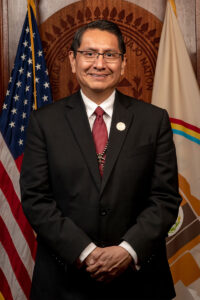Coronavirus cases slowing down on Navajo Nation
 ALBUQUERQUE – The Navajo Nation is still seeing an increase in the number of cases of coronavirus, but the rate of increase is slowing, said Navajo Nation President Jonathan Nez. This decline can be seen in the decrease in the numbers of coronavirus patients in hospitals.
ALBUQUERQUE – The Navajo Nation is still seeing an increase in the number of cases of coronavirus, but the rate of increase is slowing, said Navajo Nation President Jonathan Nez. This decline can be seen in the decrease in the numbers of coronavirus patients in hospitals.
In a town hall meeting on May 26, broadcast on television and Facebook, Nez reported that the curve of cases is flattening.
“The Navajo Nation Department of health updates us. These are the facts,” said Nez. “We continue to see an increase of COVID on the Navajo Nation. We are testing more than any other state or country. Fourteen percent of the total population has been tested on the Navajo Nation. We hear that we are above New York and New Jersey. They say that about the per capita rate. But Navajo is testing more. They portray us as poor but we are strong and resilient. What about the 23,166 who have tested negative?”
The Navajo Area Indian Health Service projected that the Navajo Nation would hit its peak for hospitalizations of patients with Coronavirus the week of May 21, but statistics show that the peak occurred the week of April 21 to April 26 so the number of cases is heading downward, Nez said. He attributed the better statistics to the Navajo people paying attention to-stay-at-home orders, social distancing, wearing masks, and following weekend and weekday curfews.
Because of these practices the people “helped flatten the curve, and we are working hard to make sure the daily numbers begin to decrease,” he added.
“A month ago we hit our peak. The Navajo Nation public worked on staying home. When I was out there, I saw that about 20 percent of the people were running around, but 80 percent stayed home. It worked. Because of you. Because the Navajo public was listening it flattened the curve. The numbers are going down. There is still a high number of people testing positive but those individuals are not going to the hospital with symptoms. They are sheltering in place. There is no need for the hospital. Curfews worked.”
Nez said that when he travels around the Nation he sees 95 percent of people wearing masks.
“Working together we can push the virus out. We must continue social distancing and washing hands. Maybe we can reopen the government. People have been cooped up in their houses. We will do it in phases. We’ll get back to some normalcy. We will keep pushing this bug off of the Navajo Nation.”
Recent statistics from the Navajo Nation Department of Health on May 28th show 4,944 total cases of the virus and 159 deaths. This is up from May 26th with 4,842 cases and 158 deaths and May 17th with 3,912 cases and 140 deaths.
The Indian Health Service and local health clinics have been testing people on the Navajo Nation for a longer time than in most areas of the country, said Doreen McPaul, the Attorney General of the Navajo Nation, who also participated in the town hall.
In a telephone interview McPaul said “the impact on medical facilities has decreased since April. There was a heavy impact of the virus. Early on we were testing.”
After the first outbreak of the virus, the impact on medical facilities was great, so the IHS created several alternate care sites on the reservation.
The media has reported for several months that the virus was especially widespread on the Navajo Nation, leading to donations of masks, thermometers, test kits and other supplies, McPaul said. “It is incredibly heartwarming.”
There has been a steady supply of donated food, water, hay for livestock, pet food, and paper products. Just this week, the National Guard came with three trucks to help unload donations.
The Navajo Nation established a website: Navajo Nation Covid19 Relief Fund. Navajo. Fund will also direct people to the website. And there is a Go Fund Me page. People have sent money and equipment, hand sanitizer, beans, rice and flour from the USA and as far away as Ireland and Korea, McPaul said. Businesses have donated gift certificates.
The Navajo Nation has received a total of $3.7 million for COVID relief, she added. “We are very grateful for this funding to assist with the needs in our communities.”
As to the $600 million that the Nation received from the CARES Act, Nez said that teams have been set up to get projects done quickly.
Communities have asked for water lines, agriculture and farming projects, windmill repairs, electricity, solar energy projects, housing, and broadband for the Internet, and scholarships.
“Here’s an opportunity to give them water. We have the money to prepare for the future,” said Nez.
(Kate Saltzstein can be reached at salty223@aol.com)
